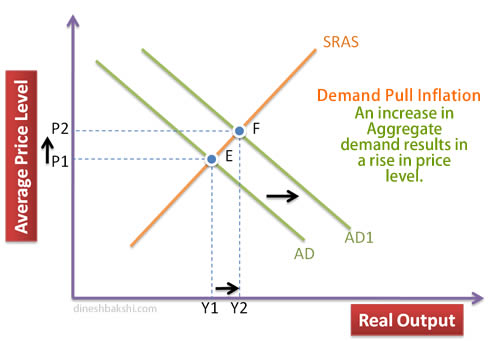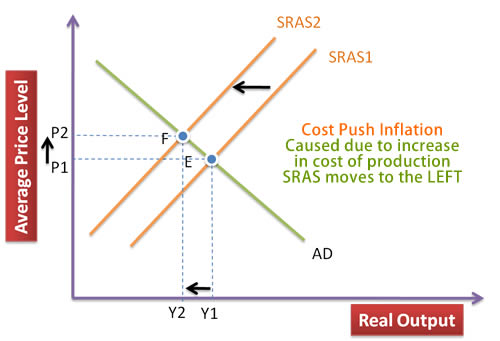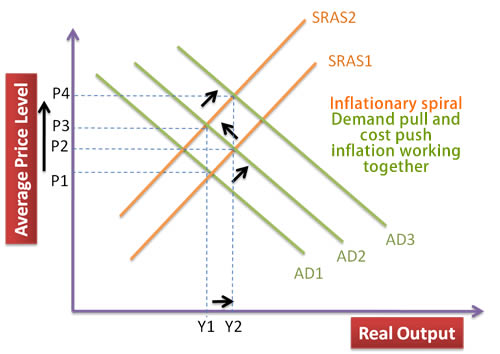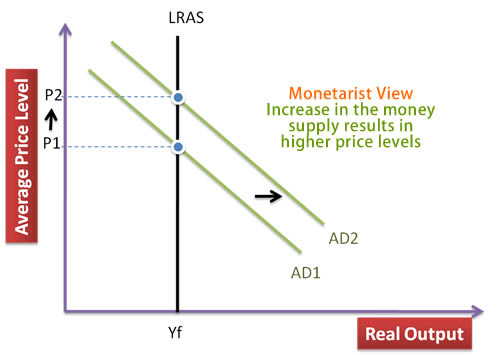Price Stability
Price stability implies avoiding both prolonged inflation and deflation.
The meaning of inflation, disinflation and deflation
What is inflation?
Inflation is a rise in the general level of prices of goods and services in an economy over a period of time.
When the general price level rises, each unit of currency buys fewer goods and services. Consequently, inflation also reflects erosion in the purchasing power of money.

What is disinflation?
Disinflation is a decrease in the rate of inflation – a slowdown in the rate of increase of the general price level of goods and services over a period of time.
For example if the annual inflation rate for the month of January is 5% and it is 4% in the month of February, the prices disinflated by 1% but are still increasing at a 4% annual rate.
What is deflation?
Deflation is a decrease in the general price level of goods and services.
Deflation occurs when the inflation rate falls below 0%.
Calculating Inflation
Rate of inflation is measured by calculating the percentage price increase in goods and services over a period of time.
Inflation is measured through a Price Index. The economists monitor the price changes of a collection of goods & services over a period of time.
There are different Price Indices that can be used, the most popular are:
- Consumer Price Index (CPI) – measure the price of a selection of goods and services for a typical consumer.
- Producer Price Index (PPI) – measures the prices for all goods and services at the wholesale level. It is like the consumer price index but it is measuring the prices the producers have to pay.
Price index consists of
A basket of goods
It contains goods and services from various sectors of the economy. There prices are monitored over a period of time.
Base year
This is the first year with which the prices of subsequent years are compared. The price of each commodity is given the value of 100. The base year chosen is a typical year in the sense that there is neither very low or very high inflation, nor any extraordinary occurrences like wars.
Weights
Some commodities are more important in the economy as compared to other commodities. To find out the true effect of inflation. Weights are added to different products and services according to their importance in the society. A product which has a more serious affect is given a higher weight. For example food products which form a staple diet of the society are assigned more weightage than luxury products (perfumes). As the pattern of consumers spending changes over time so the Price Index will have to change the weights assigned to different commodities.
Types and causes of inflation
Demand Pull inflation
This type of inflation results due to the increase in Aggregate demand in the economy. The movement of aggregate demand from AD1 to AD2 results in an increased average price level in the economy i.e. P1 to P2.

Demand pull inflation is caused due to the changes in the determinants of AD. Whenever, any of the components of AD (i.e. consumption, investment, government spending and net exports) will increase, this will result in an increase in aggregate demand.
Cost Push Inflation
Increase in cost of production will result in cost push inflation. As the cost of production increases, the firms will reduce supply. The aggregate supply will shift to the left, from SRAS1 to SRAS2. This will result in an increase in the average price level in the economy. Real output will fall.

Cost Push inflation is mainly caused due to the following factors:
· increase in wages (wage push inflation)
· increase in cost of raw materials
· increased cost of imported components (import-push inflation)
Inflationary Spiral
It is self-sustaining upward trend in general price levels due to interaction of demand pull and cost push inflation. It is also known as Wage price spiral. High cost of living prompts demands for higher wages which push production costs up forcing firms to increases prices, which in turn trigger calls for fresh wage increases ... and so on.

Monetarists view of inflation
As per monetarists (new classical economists) inflation is caused due to the excessive supply of money in the economy. According to monetarists an increase in money supply results in higher aggregate demand from AD1 to AD2. Monetarists assume the economy to operate as full employment level of output, thus, any increase in AD is purely inflationary.

Consequences of inflation
High inflation rate may result in the following adverse effects on the economy:
Greater uncertainty: There may be greater uncertainty for both firms and households. Firms will postpone their investment due to uncertainty in the market. This will result in negative implications on the economic growth in the economy.
Redistributive effects: High rate of inflation will affect people who have constant incomes, such as retired people, students, and dependents. Moreover, rise in prices of essential commodities (food & clothing) will affect the poor segment of the society as they spend a major part of their income on these good. This will lead to increased inequality in the economy.
Less saving: High rate of inflation will have an adverse effect on the savings in the economy. As people spend more to sustain their present standard of living, less is being saved. This will result in less loanable funds being available to firms for investment.
Damage to export competitiveness: High rate of inflation will hit hard the export industry in the economy. The cost of production will rise and the exports will become less competitive in the international market. Thus, inflation has an adverse effect on the balance of payments.
Social unrest: High rate of inflation leads to social unrest in the economy. There is increase dissatisfaction in among the workers as they demand higher wages to sustain their present living standard. Moreover, high rate of inflation leads to a general feeling of discomfort for the household as their purchasing power is consistently falling.
Interest rates: The Central Bank might use monetary tools to control high inflation rate by increasing interest rates. This will increase the cost of borrowing and will have a negative effect on both consumption and investment.
Shoe leather cost refers to the cost of time and effort (more specifically the opportunity cost of time and energy) that people spend trying to counter-act the effects of inflation, such as holding less cash and having to make additional trips to the bank.
Menu cost is the cost to a firm resulting from changing its prices
Consequences of deflation
Consistent fall in the general price level in the economy (deflation) might not be good news for the economy. Long term deflation will lead to:
Cyclical unemployment: Deflation usually happens to due to a fall in Aggregate Demand in the economy. This will lead to businesses cutting the output levels which will result in retrenchment/laying off of workers. Moreover, if consumers delay spending in anticipation of falling prices economic activity falls, unemployment increases.
Bankruptcies: As the value of money is increasing, it becomes difficult for debtors to repay the load. Moreover, during deflation firms will be having lower profits due to falling prices and will find it difficult to meet their liabilities. This might lead to greater number of bankruptcies. Businesses see profits fall; as they do so dividends and investment returns fall and so share prices fall.
Deflationary spiral: Consistent fall in prices may trigger deflationary spiral. As firms make less profit, this leads to less profits, they might not be willing or able to invest which will have negative implications on the economic growth. Moreover, as firms cut cost by lay off workers, there is less income for the households and the aggregate demand might fall. Due to a fall in consumer and business confidence the economy might fall into a deflationary spiral.
The principle problem of deflation is that it leads to a rise in the real value of debt. In the early stages low interest rates and low prices encourage borrowing but as the real weight of the borrowing is recognised so borrowing is reduced.
It is sometimes difficult to control deflation and Monetary policy can prove ineffective when interest rates (nominal) are already low.





